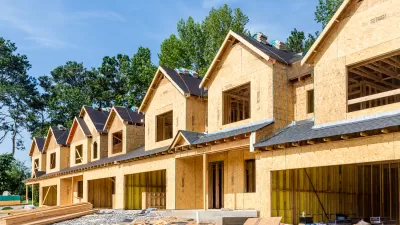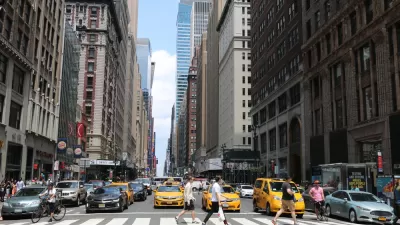Exotic street performers in the plaza have caused Mayor Bill de Blasio to reconsider his initial opposition to street plazas. Unlike his police commissioner and the governor, de Blasio has yet to make a decision on the removal of Times Square plaza.
Following through with a statements he made as a mayoral candidate in 2013 that he would consider opening Times Square and Herald Square to auto traffic, "Mayor Bill de Blasio said on Thursday that he would consider removing the pedestrian plazas from Times Square in a bid to restore order in the crowded streets of the Manhattan crossroads," writes Michael M. Grynbaum for The New York Times.
The move, which the mayor described as one of several options to be considered by a task force of New York City officials, would undo a signature accomplishment of Mr. de Blasio’s predecessor, Mayor Michael R. Bloomberg, whose decision to close part of Times Square to vehicular traffic has been hailed as an influential innovation in urban design.
"Mayor Bill de Blasio said on Tuesday (Aug 18) that he sees the women (called Desnudas - video) parading around Times Square covered in little but body paint not as creative artists, but as pushy panhandlers whose efforts to separate tourists from their money should be regulated," writes Patrick McGeehan.
De Blasio "announced a task force to consider ideas on how to better prevent activities that the city deems illegal or harmful to the area’s quality of life," writes Grynbaum. His police commissioner, William J. Bratton, who will co-chair the task force, was ready "to just dig the whole damn thing up and put it back the way it was,” he said in a radio interview.
Gov. Andrew M. Cuomo, who has often been at odds with the mayor, has already come out for the removal of the plazas.
Grynbaum goes on to write about the reaction to their possible removal in social media.
FULL STORY: Mayor de Blasio Raises Prospect of Removing Times Square Pedestrian Plazas

Pennsylvania Mall Conversion Bill Passes House
If passed, the bill would promote the adaptive reuse of defunct commercial buildings.

Planning for Accessibility: Proximity is More Important than Mobility
Accessibility-based planning minimizes the distance that people must travel to reach desired services and activities. Measured this way, increased density can provide more total benefits than increased speeds.

Fair Housing Cannot Take a Back Seat to ‘Build, Baby, Build’
If we overlook fair housing principles in the plan to build US housing back better, we risk ending up right back where we started.

LA Metro Board Approves New 710 Freeway Plan
The newest plan for the 710 corridor claims it will not displace any residents.

Austin’s Proposed EV Charging Rules Regulate Station Locations, Size
City planners say the new rules would ensure an efficient distribution of charging infrastructure across the city and prevent an overconcentration in residential areas.

Making California State Parks More Climate-Resilient
A recently released report offers recommendations for keeping state parks healthy and robust, including acquiring additional land for conservation and recreation.
City of Costa Mesa
Licking County
Barrett Planning Group LLC
HUD's Office of Policy Development and Research
Mpact Transit + Community
HUD's Office of Policy Development and Research
Tufts University, Department of Urban and Environmental Policy & Planning
City of Universal City TX
ULI Northwest Arkansas
Urban Design for Planners 1: Software Tools
This six-course series explores essential urban design concepts using open source software and equips planners with the tools they need to participate fully in the urban design process.
Planning for Universal Design
Learn the tools for implementing Universal Design in planning regulations.
























